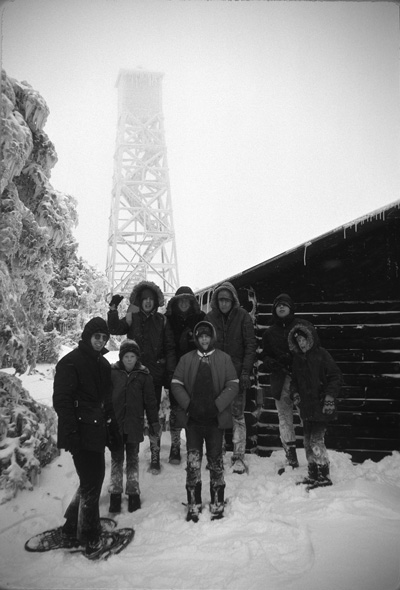News
To conserve and protect
Scouting group keeps multi-generational link to Vermont forest
By TELLY HALKIAS
Contributing writer
STRATTON, Vt.
More than a half century ago, a Boy Scout group from Delaware bought a tract of land in the Green Mountains that has become an enduring example of private environmental stewardship.
Today, one of those Scouts, Ross Lanius of North Haven, Conn., walks the Stratton woods in the area known as Snowald at least once a year, sometimes more.
Lanius is 77 now, and he’s handed off management of the property to his son Brian, of Montvale, N.J., who first visited Snowald when he was 2 months old. And Brian Lanius, now 51, has been bringing his own son to Snowald for more than a decade.
The 250-acre property, high in the mountains, has a small cabin and some wooden platforms for tents. Other than that, the land is mainly forested, and Ross Lanius said the scouting group has gradually learned about conserving and managing the properties over decades of enjoying its use.
Since the 1950s, Snowald has been used primarily as a gathering place for Boy Scout troops to experience nature. But its neighbors know it as a place open to hikers, hunters and skiers.
The culture inherited by Brian Lanius and younger members of the Boy Scout group is seen today by the likes of Mary Beth Adler, a field technician and coordinator for the state’s Wildlife Habitat Incentives Program, through which Snowald has nurtured a considerable number of trees.
“I am most impressed by the intentional way that the Snowald folks are caring for the land,” Adler said. “They seek out help from professionals, and they have provided for the land to be cared for in perpetuity through conservation easements. They are willing to educate others, and they have a contagious enthusiasm in doing it.”
Bloodlines take root
The Scouts and their adult guides were motivated to acquire Snowald in the 1950s through their troop’s emphasis on environmental education. Caring for the property introduced them to the experience of voluntary stewardship.
At first, they came to Vermont to help maintain the Long Trail, an effort led by the late Theodore Talbot, a local environmentalist who died in 1994.
“Our boyhood friendships really set the stage for decades of camaraderie as well as land stewardship,” Ross Lanius said. “We thought we’d just come to help out Ted Talbot, but here we are, in a new century, with our own kids and grandkids.”
Those early visits made the group want to find its own place in the Green Mountains, Lanius recalled.
“Our advisers and Ted Talbot spent many weekends during 1956 traveling the back roads of Vermont looking for the ideal location,” he said.
They wanted a place suitable for outdoor adventures, forest and wildlife conservation.
The group discovered a property in Stratton, which even then had become a major winter sports destination.
The Appalachian Trail and Long Trail run several miles west of Snowald. Peppered with hiking trails, old logging roads and the occasional meadow, Snowald’s rolling terrain is dense with pine, birch, maple and spruce, and it’s home to several apple orchards and an abandoned beaver habitat.
Although the group advisers involved in the purchase contributed a larger monetary slice than the Scouts, everyone decided that future expenses would be split equally. They then organized Snowald as a Delaware nonprofit corporation. Its constitution and by-laws state that its goal is to “purchase, acquire, hold, develop and maintain land for education, conservation, recreation and similar uses, and thereby to promote outdoor sports, camping and other activities.”
Guarding the land
Positioned as it is along the north-south spine of the Green Mountains in a dense snow belt, Snowald’s name, a play on the German schneien wald (snowy woods), seemed appropriate.
The corporation bought the land on May 18, 1957. The deed described the property as “225 acres more or less.” A more recent survey fixed the acreage at 254.
Given that the owners lived 350 miles away, their early efforts to care for the property were mixed.
One of the founding members of Snowald, Jim Satterfield of Newark, Del., remembers the early years as “trying to do forestry by the seat of our pants.”
Satterfield, 82, said the Boy Scouts and their advisers at first just cleared underbrush and trees downed by the wind, occasionally installing water bars across eroded trails.
But in 1959 they started to get more organized with the help of Rick Kelly, a consulting forester from Manchester.
“We planted 500 red spruce and 500 red pine seedlings,” Satterfield said. “Over the years, much natural reforestation has taken place in that area and others.”
Over the ensuing decades, the Scouts planted more trees, girdled trees, opened woods roads and cleared trails for hiking and cross-country skiing.
In 1990, Snowald entered an agreement with Ranger Resource Co. of Manchester for sales of timber and for the development of a silvicultural harvesting system. The pact covered beech, sugar maple, hard maple and yellow birch trees.
For the next decade, the Snowald group had extensive discussions with the Vermont Land Trust regarding forest management plans and possible interaction with the Vermont Association of Snow Travelers, a coalition of snowmobiling clubs that maintains trails throughout the state. Snowald’s members shelved both ideas for lack of time and money.
More recently, however, financial realties forced land management changes at Snowald. After 1997, when the Legislature passed Act 60, a law meant to equalize per-pupil education spending between richer and poorer towns, landowners in “gold” towns like Stratton saw their property taxes increase dramatically. Snowald suddenly faced financial pressure to sell off some of its land for developers.
“We are not far from some of the best skiing in the Northeast, and the town of Stratton zoned this land for mixed use, to include residential,” Ross Lanius said. “When our taxes skyrocketed, we had to develop a plan -- or spend ourselves out of existence.”
The answer came in 2000, when Snowald joined the state’s Use Value Appraisal, or “current use,” program. Through this program, the town of Stratton taxed the corporation for the two acres on which its cabin remained as residential but significantly lowered the tax bill on the remaining 252 acres, as these were deemed protected woodland with demonstrated timber production potential.
Forestry and animal habitats
Adler has since worked with the leaders at Snowald to create several large wildlife openings on the property. These openings were planned together with Snowald’s consulting forester, George Weir of Williamsville, and incorporated into Snowald’s forest management plan.
“The openings were meant to create young forest habitat for a variety of wildlife species that depend on this early successional type of habitat for all or part of their life cycles,” Adler explained.
Creating the openings for wildlife also allowed Snowald to harvest mature and older trees, setting the stage for the next generation of trees to grow.
Two of the openings were created in hardwood stands. The group expects that as these two areas regenerate, they will provide habitat suited to ruffed grouse, black bears and bobcats. The open areas also are suitable for songbirds such as chestnut-sided warblers, common yellowthroats and white-throated sparrows.
Adler said the openings in the forest also will benefit hawks and owls as places to forage for mice, voles and other small mammals.
Snowald also has created three long, narrow openings – known as strip or patch cuts – in an over-mature stand of spruce and balsam fir. These were designed specifically to create habitat conditions preferred by snowshoe hares. The dense, thick cover that will result from the cutting helps the animals to avoid predators. This initiative was supported by both Weir and Brian Lanius, who is now president of the corporation.
Brian Lanius said the patch cuts were broken down into a five-acre cut, a two-acre cut, and a series of strips in a decrepit balsam stand.
“The two larger cuts looked like complete devastation when they were done,” Lanius said. “They seemed so different that on my first walk around the perimeter of the larger cut, I became disoriented on land that I had been walking over for the past 50 years. I walked halfway around and got to the stream in back, but coming in on a freshly made skid path and with the large cut adjacent to it, I didn’t recognize it.”
Just two years later, he added, those cuts have experienced significant regeneration. There is now evidence of substantial animal activity, including browsing by moose and deer.
Set for a new generation
Fun, business, and conservation continue to exist harmoniously at Snowald. The Laniuses and other Snowald members display an intimate connection to individual trees and landmarks on the property. They point them out and recall past visits, telling the story behind a tree or a bend in a trail, and unintentionally showing off the knowledge of forestry and natural resource that they’ve gained over the years.
As some of Snowald’s original members have died, the corporation has invited new members – mostly children of the founders – to join.
“All of the surviving founders remain involved in some way but, because of distance and health can’t make it up here as frequently as they once did,” Brian Lanius said. “Ross is close by in Connecticut and comes a few times a year, but a new generation of members is starting its own traditions.”
Brian brought his own son, Cristian, now 12, to Snowald several months after his first birthday, and the boy’s developing knowledge of the outdoors is a tribute to Snowald’s legacy.
“I don’t think the founding members of Snowald had any awareness of the magnitude of what they accomplished,” Brian Lanius said. “Their foresight hopefully locked this land away from development forever.”

